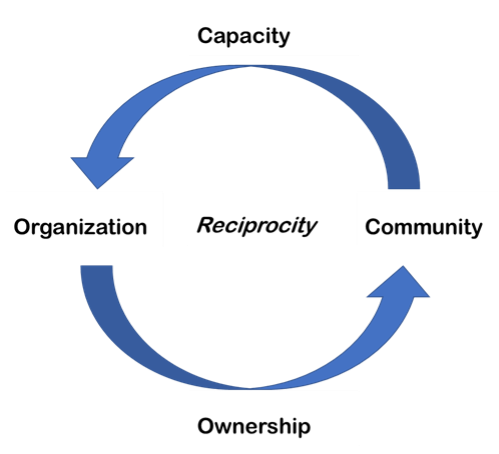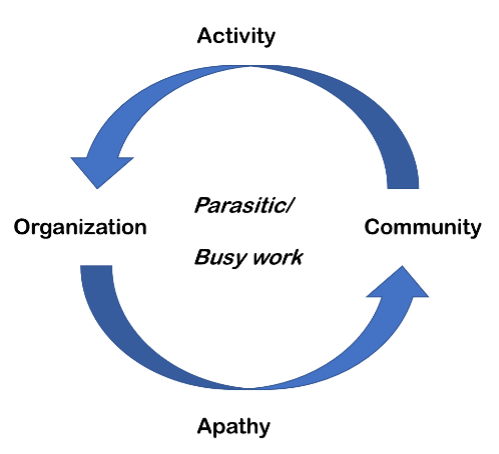Radical Welcome as a Guide for Community Engagement

From the outside, the large agency looks like a model nonprofit when it comes to involving volunteers. It hosts a significant volunteer and paid staff team. There are volunteer applications, legal waivers and comprehensive training. The team is guided by operational plans based on lessons learned from the corporate world and nonprofit consultants. The leadership heeds and hones best practices for volunteer management; it collects and makes decisions using many, many data points. It has come a long way from its humble all-volunteer roots.
From the inside, it is a more complicated story. There is a reliance on technology and standardized processes that proves to be ill-suited for some of its very human and non-standardized day-to-day work. There is a tendency to oversee or micromanage volunteers in so-called ‘leadership’ positions despite these volunteers completing rigorous training and demonstrating competence in their roles. Volunteers tend to be older, white, well-off and educated and do not reflect many people served. This disconnect between those serving and those served can be a liability because the organization’s mission relies on connection and trust.
This nonprofit could put on a clinic for implementing volunteer management practices based on models designed for paid staff. The approach has served its leaders well in crafting processes and managing the logistics of volunteerism. Yet it has left something to be desired for the people and community elements of the work.
Radical Welcome as a Portal to Possibility

By no means is this nonprofit an anomaly. The agency and many others like it, are why the notion of radical welcome and how it might help us shape volunteer engagement captivated my attention when a colleague first introduced it.
One of the reasons was because of how easy it is to get caught up in the logistics of volunteer engagement. I have witnessed how that emphasis can lead us to creating volunteer projects that are a series of transactions. Building a sense of community through and beyond service can get lost in the hustle. I wondered what volunteer or community engagement would look like if guided by radical welcome.
My curiosity deepened after reading Radical Welcome1 by Reverend Stephanie Spellers. Though her audience is mainly religious congregations, her lessons apply to agencies whose work is rooted in the community. It is especially relevant for those that are engaging volunteers and working toward creating more just organizations and communities.
Rev. Spellers offers an entry into these community and people conversations in a way that enlivens and ignites. Her approach seems particularly important now because the way we start these conversations matters if we are going to sustain them. Too often, these conversations do not find traction beyond Volunteer Directors. For example:
- Students in my Volunteer Engagement class often share that volunteerism is treated as an afterthought in their agencies. Their co-workers see volunteers as needy or burdensome. The students find it hard to garner attention or participation in volunteer engagement by senior leaders or staff who do not see volunteers as essential partners in meeting the mission or as a way to partner with the community. As a result, the benefits of volunteer engagement are limited.
- A colleague shared that his (white) co-workers left a training on implicit bias saying they were called racists. My colleague was shocked and on the alert when he went into the training the following week. No one was called a racist, but it was clear that the training missed the mark and did not change the organization in a positive way. The language around bias and diversity came across like an exercise in obligation and compliance to some. As such, it felt like a box to check rather than an opportunity for learning and growth.
It does not have to be this way.
What if volunteer engagement was framed as a meaningful way to engage the full potential of the community? To be a portal into the possibilities that emerge when working toward a collective goal? How might that lead to a more generous practice of community—or as Rev. Spellers puts it—to radical welcome where the “voices, presence, and power of many groups” shape nonprofit work?
Could this shift in language help us show up in a more productive way? Would a reframing help us prioritize the voices, presence, and power of our participants, community, and volunteers as well as our funders and boards? Does it move us closer to being in right relationship2 with the many people in our communities?

Getting Back to Nonprofit Roots
Rev. Spellers’ use of the word radical intrigued me. A visit with Merriam-Webster revealed my understanding of radical was the default definition3: extreme or very different from the usual or traditional. Yet, there was another meaning of radical: proceeding from a root or relating to the origin. In fact, the root of radical is…root.
Most nonprofits’ roots are in the community. They start with a group of people who see a need and decide to meet that need. If the group grows, it may incorporate into a nonprofit and start to raise more money and hire staff. They may feel pulled to start playing by the rules of funders rather than the needs of the community.4 The bigger an agency gets, the more rules there are to satisfy: how to work with donors and secure contracts, how to develop a strategic plan and logic model and business case, how to generate awareness. The list goes on and on.
If we are not careful, we get further away from our roots. And somewhere along the way, it becomes radical (extreme or very different) to suggest that we act in radical (root or fundamental) ways that prioritize the voices, presence, and power of our participants and community.
We end up having to be given permission to welcome the people we serve. We might turn to the business trend of human-centered design to allow us to return to our roots. Yet, despite (or perhaps because of) the buzz around human-centered design, the idea of radical welcome animates and energizes me in a more profound way. Radical welcome is not about business; it is about community.
Community as a Continuum
So, what is radical welcome? In her book, Rev. Spellers shares a continuum of welcome to illustrate the concept. I also share insights into it from the perspective of the colleague who introduced me to this work.
- Assimilation: A group invites new members to join and participate in the dominant culture. These groups are mainly monocultural. As my colleague explained it, “Welcome! We see you are different from us. You’ll fit right in if you adopt our ways.”
- Incorporation: A community welcomes marginalized groups to make them more diverse but without a shift in cultural identity or practices. These groups might have pockets of diversity that operate on the margins of the dominant culture. Again interpreted by my colleague, “Welcome! We see you are different from us. We have a committee [or program] for that!”
- Incarnation (or mutual transformation, for a more secular term): A “community embodies and expresses the full range of voices and gifts present, including the Other.” These groups welcome the whole person and share power among their members. Or as my colleague shared, “Welcome! We look forward to the ways our community will be transformed because you are here.”
It is easy to find a parallel application for this continuum of welcome in volunteer engagement.
- Assimilation: Picture an organization that is humming along with a solid volunteer corps made up of people with similar characteristics or backgrounds. Everyone wonders why newcomers who are “different” than the mainstream group do not stick around.
- Incorporation: These agencies have a group of “diverse” volunteers serving one kind of program (which is probably labeled outreach). They are the volunteers who make the cover of the brochure (youth! people of color! someone with a disability!) to demonstrate how diverse or progressive the agency is. Volunteers from this program might find it hard to be successful in other agency roles or feel like they are tokens.
- Incarnation, mutual transformation or radical welcome: This is the agency that partners with many types of volunteers. They may hail from the local community, the participant/client pool, and beyond. Volunteers help make program decisions and hold positions of leadership. They attend team meetings and are agency ambassadors alongside staff.
For many agencies, the shift from assimilation to mutual transformation is a leap—and a radical one at that. The beauty of mutual transformation, though, is that it aligns volunteer engagement and equity, diversity and belonging with agency roots. We remember that volunteer engagement is really community engagement. As such, volunteer engagement is a strategy for putting equity, diversity and belonging into practice. Conversely, it is a practice that needs to be grounded in equity, diversity and belonging principles.
Community Engagement Done Well
This idea of radical welcome or mutual transformation aligns well with research about the value volunteers bring to their agencies that I conducted with 10 experts in volunteerism. Their perspectives led to the creation of the model below.
They noted that when we get volunteer engagement right, we set up our agencies for a reciprocal and interdependent relationship with the community. Meaningful volunteer opportunities provide a way for volunteers to infuse the organization with capacity in the form of talent, connections, expertise, money, skills, in-kind gifts and passion.

When the experience is positive, they return to the community with a sense of ownership and partnership in the mission. They are more aware of what the agency does. They experience the mission and impact firsthand. They gain a sense of voice and are poised to be effective ambassadors. Equally important, this cycle has valuable by-products: trust, good will and confidence in the agency. These by-products are critical to organizational success, yet are not the kind of things that can be easily bought or measured. They have to be earned through relationship.
This virtuous cycle, however, does not occur just by having volunteers in our organizations. An Urban Institute study5 found that the more agencies invested in their volunteer engagement strategies, the more benefits those agencies received. Which is to say that if we hold volunteers and the community at arm’s length and only provide shallow or limited opportunities for involvement, we constrain their ability to contribute to and share our collective work. Deeper engagement and the connection that comes from radical welcome, although more complicated, yield more of the outcomes that align with success.
I wonder what the flipside of this model might look like, one where an agency does not engage the community well. Where volunteers spend their time in activity that is divorced from the mission of the organization. Where they leave with a sense of apathy, or perhaps pat themselves on the back for a job well done before going back to “real” life. Where the interactions feel parasitic, drawing down the energy and morale of staff for what is perceived to be volunteer busy work. Or where the program participants tell stories that make the volunteers feel good but leave them feeling devalued and disrespected. This kind of service yields different by-products: distrust, poor retention, a lack of confidence and wasted time.

Many of us have heard about or served in one of these experiences. We know how important it is to embrace a radically different way of being.
Radical Welcome in Volunteerism
So, how do we begin to practice radical welcome? Rev. Spellers offers guiding questions to help communities reflect on where they are and where they want to go. They are adapted below for the volunteer space. I added brackets to clarify or expand points.
- Is there an assumption that some groups are “the objects of service but not subjects with whom [we] engage in partnership and embrace”?
- “Who is not at the table? Who would never even come to the door because they are so sure we will not receive them, because, historically, we have not?”
- “…which supposed essentials and non-negotiables [of volunteer or community engagement] are in fact simply preferences, where [we] might be able to make room for another voice or perspective to enrich, enhance, stand alongside and even transform the one generally privileged”?
- How do current volunteer roles and projects “help people to build authentic mutual relationships between” all involved and look “less like serving ‘them’ and more like genuine partnership?”
- “How could [we] engage in:
- becoming an ally with those who lack [our] power and access, advocating and seeking justice in the wider community and society?”
- community gatherings and celebrations that reflect the priorities and styles of different groups?”
- activities that help [volunteers, staff, and community members] to share stories and cross boundaries?”
- stewardship programs that truly welcome the gifts of all [participants], sincerely highlighting the value of time and talent and not just large financial contributions?”6
- “What processes or mentors [not saviors] need to be in place to support folks who have not traditionally held power to exercise their voice?”
- “What has it cost us…not to have the other as a full, engaged member of [our agency] and community?”
These questions move Volunteer Engagement beyond logistics and transactions. They make space for connection and relationship. They help us shift from including someone who we have othered to creating a community where everyone belongs. They move us toward reciprocity and honor that we all have something to give and something to receive.
They also position Volunteer Engagement to be a compelling organizational strategy, particularly as agencies consider how to share power and invite the fuller participation of the communities being served. It is easier said than done, I know. I appreciate that many Volunteer Directors struggle to influence senior leadership and exercise authority.
However, I also know the Volunteer Director position is powerful—operating at the nexus of community and agency—even if that power is often overlooked. You are the closest witnesses to what happens when the community is engaged well through service (or not). You have the expertise to transform capacity into ownership and community. Therefore, your voice is essential for communicating the contributions that volunteers make to advance the mission and operations of the organization. It takes courage. It takes perseverance. It takes a commitment to getting radical.
Perhaps the first step, then, in radical welcome is to radically welcome the advocacy that comes with facilitating service in our agencies and communities. And the part of you that can return us to our roots.
_______________
End Notes
1 See Radical Welcome by Reverend Stephanie Spellers
2 Musings from the Sandbox: Right Relationship
3 https://www.merriam-webster.com/dictionary/root#etymology
4 Can Volunteers Help Nonprofits Keep Their Community Roots Alive? by Sue Carter Kahl at Nonprofit Quarterly
5 Volunteer Management Capacity in America’s Charities and Congregations by Urban Institute.


Sue Carter Kahl/ Sue Carter Kahl Consulting/ San Diego, CA, USA
Wed, 07/14/2021In the time between submitting the article and it being published, I started to rethink using the term 'ownership' in the model that talks about what volunteers bring back to the community when it's a good experience (under Community Engagement Done Well heading). My sense is that no one really owns the mission. Perhaps a better word might be partnership or a sense of stewardship or relationship with the mission. I'm always refining the models and would love to hear what you think might be a stronger term than ownership.
Comments, reactions, and ideas welcome (for the wording or any other part of the article)!
Nicky Forster, Nillumbik Shire Council, Melbourne Australia
Fri, 08/13/2021Thanks so much for this valuable and thought-provoking contribution, Sue.
It’s interesting to think of from the perspective of local government (where I work), where the notion of ‘mission’ is less singular, where perhaps the mission of volunteer programming is simply ‘inclusive representation meeting community needs’.
In that sense, radical welcome is even more fundamental to the purpose of volunteering. A very helpful model in which community building is forefront!
Sue Carter Kahl/ Sue Carter Kahl Consulting/ San Diego, CA, USA
Tue, 08/17/2021Thanks for sharing your insights, Nicky, and reminding us that radical welcome is not limited to nonprofit settings. I love the way you frame volunteerism as 'inclusive representation meeting community needs'. It really shifts and deepens the role of volunteer administrator.